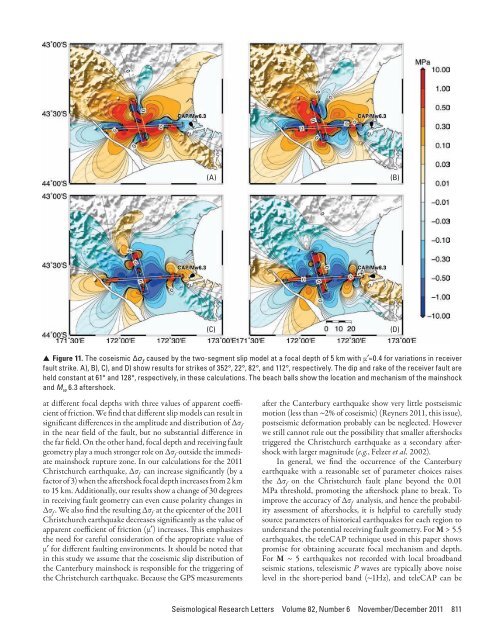Here - Stuff
Here - Stuff
Here - Stuff
Create successful ePaper yourself
Turn your PDF publications into a flip-book with our unique Google optimized e-Paper software.
(A)(B)(C)(D)▲▲Figure 11. The coseismic Δσ f caused by the two-segment slip model at a focal depth of 5 km with μ′=0.4 for variations in receiverfault strike. A), B), C), and D) show results for strikes of 352°, 22°, 82°, and 112°, respectively. The dip and rake of the receiver fault areheld constant at 61° and 128°, respectively, in these calculations. The beach balls show the location and mechanism of the mainshockand M w 6.3 aftershock.at different focal depths with three values of apparent coefficientof friction. We find that different slip models can result insignificant differences in the amplitude and distribution of Δσ fin the near field of the fault, but no substantial difference inthe far field. On the other hand, focal depth and receiving faultgeometry play a much stronger role on Δσ f outside the immediatemainshock rupture zone. In our calculations for the 2011Christchurch earthquake, Δσ f can increase significantly (by afactor of 3) when the aftershock focal depth increases from 2 kmto 15 km. Additionally, our results show a change of 30 degreesin receiving fault geometry can even cause polarity changes inΔσ f . We also find the resulting Δσ f at the epicenter of the 2011Christchurch earthquake decreases significantly as the value ofapparent coefficient of friction (μ′) increases. This emphasizesthe need for careful consideration of the appropriate value ofμ′ for different faulting environments. It should be noted thatin this study we assume that the coseismic slip distribution ofthe Canterbury mainshock is responsible for the triggering ofthe Christchurch earthquake. Because the GPS measurementsafter the Canterbury earthquake show very little postseismicmotion (less than ~2% of coseismic) (Reyners 2011, this issue),postseismic deformation probably can be neglected. Howeverwe still cannot rule out the possibility that smaller aftershockstriggered the Christchurch earthquake as a secondary aftershockwith larger magnitude (e.g., Felzer et al. 2002).In general, we find the occurrence of the Canterburyearthquake with a reasonable set of parameter choices raisesthe Δσ f on the Christchurch fault plane beyond the 0.01MPa threshold, promoting the aftershock plane to break. Toimprove the accuracy of Δσ f analysis, and hence the probabilityassessment of aftershocks, it is helpful to carefully studysource parameters of historical earthquakes for each region tounderstand the potential receiving fault geometry. For M > 5.5earthquakes, the teleCAP technique used in this paper showspromise for obtaining accurate focal mechanism and depth.For M ~ 5 earthquakes not recorded with local broadbandseismic stations, teleseismic P waves are typically above noiselevel in the short-period band (~1Hz), and teleCAP can beSeismological Research Letters Volume 82, Number 6 November/December 2011 811
















